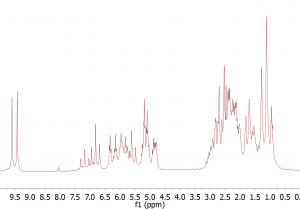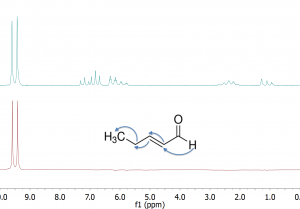In my last post I showed how the 2D TOCSY experiment can be used to identify individual “spin systems” or subunits within a molecule, or even within different molecules. Well, there is a very closely related, one-dimensional version of the TOCSY experiment that uses something called “selective excitation” in place of a full 2D experiment. This has the advantage that it is both quicker to run and easier to understand. The basic idea behind this so-called 1D TOCSY experiment is quite straightforward: first, a combination of shaped rf pulses and magnetic field gradients is used to selectively excite one signal in the spectrum; then, a special pulse sequence element called a “spinlock” is used to transfer magnetization from the “excited” spins to the other spins in the spin system, in exactly the same way as is done in 2D TOCSY. The result is a 1D spectrum in which only signals that appear from those that are in the same spin system as the excited signal. This 1D TOCSY experiment can be very useful in a number of situations, particularly when there is considerable overlap in the spectrum. It’s a quick experiment, too, typically taking only a minute or two to run.
Let’s return to our mixture of 2-pentenal and 5-epoxyhexene. As discussed before, the proton spectrum shows a lot of overlap between the signals from the two sample components.
Fig. 1. Proton spectrum of a mixture of 2-pentenal and 5-epoxyhexene. The spectrum shows considerable overlap between the signals from the two components.
However, there is one well resolved resonance at 9.5 ppm, that of the aldehyde in 2-pentenal. With TOCSY 1D we can selectively excite this signal, as shown in the lower spectrum of Fig. 2 below. Then, we can use a TOCSY spinlock to transfer magnetization from the aldehyde proton to the other protons in the 2-pentenal spin system, resulting in the top spectrum of Fig. 2.
Fig. 2. 1D TOCSY of sample of 2-pentenal and 5-epoxyhexene. In the lower spectrum, selective excitation of the aldehyde resonance was achieved using a double pulse field gradient spin echo (DPFGSE) with a pair of “q3” Gaussian Cascade shaped frequency-selective pulses. In the top spectrum, an additional TOCSY transfer from the aldehyde proton to other protons in 2-pentenal was achieved using a 150 ms DIPSI-2 spinlock. Undesirable zero-quantum coherence responses were suppressed using the method of Thrippleton and Keeler1 that employs a pair of adiabatic pulses in the presence of field gradients.
Fig. 3 below shows a comparison of the TOCSY 1D spectrum of our sample mixture with the original proton spectrum of the mixture and a proton spectrum of pure 2-pentenal.
Fig. 3. Comparison of 1D TOCSY spectrum of a mixture of 2-pentenal and 5-epoxyhexene with the proton 1D spectrum of the mixture and the proton 1D spectrum of 2-pentenal.
As you can see, in addition to aiding the identification of spin systems, the 1D TOCSY experiment also provides a very powerful way of “editing” the spectrum to remove signal overlap and simplify the spectrum – only signals from 2-pentenal show up in the 1D TOCSY spectrum above.
The Spinsolve benchtop NMR spectrometer is available with software to support pulse programming capabilities, including shaped rf pulses and gradients for coherence selection. If you have any questions or want to discuss how the TOCSY or other NMR methods can help with your application please Contact Us
References
“Elimination of Zero-Quantum Interference in Two-Dimensional NMR Spectra”, Michael J. Thrippleton, and James Keeler, J. Angew Chem Int Ed 2003; 42; 3938-41.
Acknowledgements
Many thanks to Dr. Alan Kenwright of Durham University for the sample used here and for the generous use of their Spinsolve system equipped with gradients.


